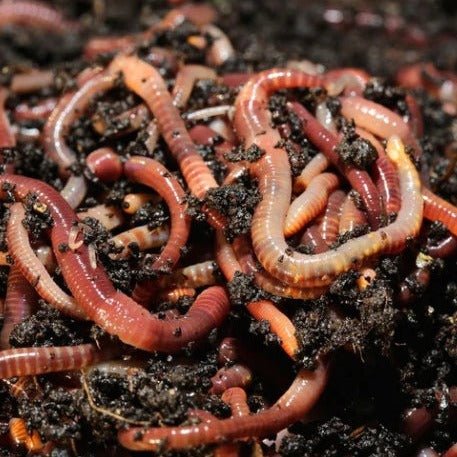The Extraordinary World of Red Wigglers: Boost Your Soil Fertility Today
The function of red wigglers, or Eisenia fetida, in boosting dirt fertility is a subject of expanding rate of interest among garden enthusiasts and agricultural specialists. These small yet effective microorganisms change natural waste right into valuable worm castings, considerably enhancing soil wellness and promoting lasting methods. As we explore the advantages of vermicomposting and the useful actions to produce an effective worm container, the potential influence of these worms on your gardening success comes to be progressively evident. Recognizing the subtleties of their care and application might just transform the way you come close to soil administration. What understandings can be acquired from incorporating these amazing animals into your horticulture regimen?
Recognizing Red Wigglers
Red wigglers, scientifically called Eisenia fetida, are a types of earthworm that play an essential function in boosting dirt fertility. These worms thrive in organic-rich environments, such as compost stacks and decomposing plant product, where they consume organic waste and excrete nutrient-dense castings. Their special makeup, including a fractional body and a clitellum, permits them to recreate quickly and effectively procedure big quantities of raw material.

The environmental importance of red wigglers expands past mere waste handling; they add to the soil food internet, promoting a diverse area of bacteria that further boost soil wellness. Comprehending the biology and behavior of red wigglers is essential for utilizing their complete capacity in sustainable farming and gardening techniques.
Benefits of Vermicomposting
(Lake Rhodhiss Bait)Utilizing the power of red wigglers via vermicomposting offers many benefits that substantially enhance soil wellness and fertility. One of the main advantages is the production of nutrient-rich worm spreadings, which are an excellent all-natural plant food. Red Wiggler Express. These castings consist of essential nutrients like nitrogen, phosphorus, and potassium, advertising robust plant development and boosting crop returns
The existence of worm castings boosts dirt appearance, enabling for much better water retention and water drainage. Red wigglers aid damage down natural matter, increasing decay and reusing nutrients back right into the soil.
Vermicomposting additionally cultivates microbial activity, which is crucial for a healthy and balanced soil environment. Beneficial bacteria prosper in the visibility of worm spreadings, helping in the malfunction of natural materials and improving nutrition accessibility to plants.
Finally, vermicomposting serves as an effective waste management solution, reducing land fill waste by reusing cooking area scraps and other organic materials. This not just adds to environmental sustainability but also advertises a round economic climate within gardening and agriculture.
Just How to Establish a Worm Bin
Establishing a worm container is a simple process that can significantly boost your composting initiatives. Begin by choosing an appropriate container, which sites can vary from a readily available worm container to a basic plastic or wooden box (Red Wiggler Express). Ensure the container has ample ventilation; small openings in the lid and sides will promote air flow
Following, create a bed linens layer to supply a comfortable setting for the red wigglers. This can be made from shredded paper, cardboard, or coconut coir, moistened to a wet, sponge-like consistency. Load the bin to around one-third full with this bed linens material.
As soon as the bed linen is prepared, it's time to introduce the worms. Red wigglers prosper in organic waste, so area them gently onto the bed linens. Cover the worms with a light layer of additional bed linens to help them accommodate.
Feeding Your Red Wigglers
Supplying the right food for your red wigglers is crucial for their health and the performance of your composting system. Red wigglers thrive on a different diet, mainly being composed of organic products such as fruit and vegetable scraps, coffee grounds, and shredded paper. These products not only offer crucial nutrients but additionally contribute to the microbial activity in the worm container, which is crucial for the worms' digestion.
It is very important to avoid specific foods, such as milk items, oils, and meats, as these can attract insects and develop undesirable odors. Furthermore, citrus peels and excessively zesty foods should be limited because of their possible to damage the worms. A balanced method to feeding includes monitoring the amount of food introduced to the bin, making sure that it is eaten within a reasonable time frame to stop excess waste build-up.
To advertise optimum food digestion, it is beneficial to chop or shred larger food items before adding them to the bin. This method enhances the surface location for microbial action, assisting in quicker disintegration and boosting the total performance of your composting system. Regularly observing the worms' feeding habits will help you adjust their diet as necessary.
Making Use Of Worm Spreadings in Your Yard

(Red Wiggler Express)Incorporating worm castings right into your yard can be achieved by mixing them into the soil or utilizing them as a leading dressing. The slow-release nature of these spreadings makes certain that nutrients are offered to plants over a prolonged period, lowering the demand for synthetic fertilizers. In addition, worm castings contain beneficial microbes that promote healthy dirt communities, enhancing the total durability of your yard.
To make best use of the benefits, aim to use roughly one component worm castings to 3 parts dirt in your planting beds. Normal applications can result in improved crop returns and healthier plants, making worm spreadings a vital resource for both newbie and skilled garden enthusiasts alike. By utilizing this all-natural amendment, you can cultivate a thriving garden while adding to sustainable horticulture practices.
Final Thought
Finally, red wigglers exemplify the essential function of vermicomposting in boosting soil fertility. Their capability to transform organic waste into nutrient-rich spreadings significantly enhances dirt structure and supports microbial variety. Developing a vermicomposting system not only promotes lasting horticulture practices however additionally adds to environmental wellness. By leveraging the benefits of these amazing microorganisms, garden enthusiasts can cultivate extra productive and durable ecological communities, ultimately promoting a much more lasting approach to agriculture and gardening.